高考英语主谓一致
- 格式:doc
- 大小:77.00 KB
- 文档页数:9
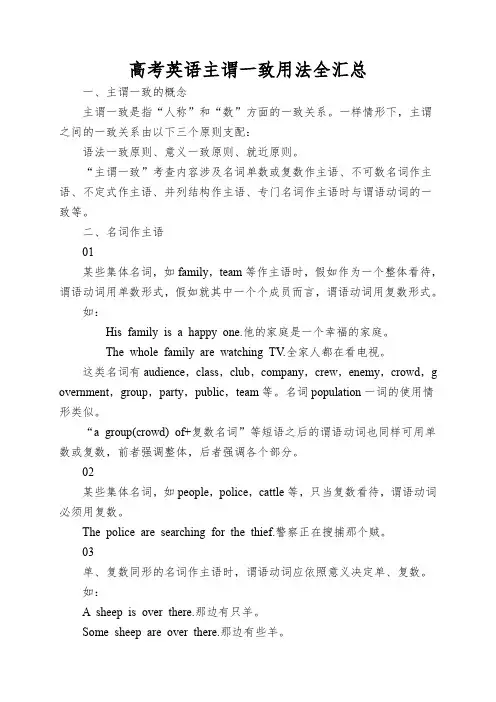
高考英语主谓一致用法全汇总一、主谓一致的概念主谓一致是指“人称”和“数”方面的一致关系。
一样情形下,主谓之间的一致关系由以下三个原则支配:语法一致原则、意义一致原则、就近原则。
“主谓一致”考查内容涉及名词单数或复数作主语、不可数名词作主语、不定式作主语、并列结构作主语、专门名词作主语时与谓语动词的一致等。
二、名词作主语01某些集体名词,如family,team等作主语时,假如作为一个整体看待,谓语动词用单数形式,假如就其中一个个成员而言,谓语动词用复数形式。
如:His family is a happy one.他的家庭是一个幸福的家庭。
The whole family are watching TV.全家人都在看电视。
这类名词有audience,class,club,company,crew,enemy,crowd,g overnment,group,party,public,team等。
名词population一词的使用情形类似。
“a group(crowd) of+复数名词”等短语之后的谓语动词也同样可用单数或复数,前者强调整体,后者强调各个部分。
02某些集体名词,如people,police,cattle等,只当复数看待,谓语动词必须用复数。
The police are searching for the thief.警察正在搜捕那个贼。
03单、复数同形的名词作主语时,谓语动词应依照意义决定单、复数。
如:A sheep is over there.那边有只羊。
Some sheep are over there.那边有些羊。
04名词所有格之后的名词被省略,这种情形一样只指商店、工厂、住宅等,作主语时,动词一样用单数。
如:The doctor’s is across the street.诊所在街道的对面。
My uncle’s is not far from here.我叔叔家离这儿不远。
常见的省略名词有the baker’s,the barber’s,the carpenter’s,the Zhang’s等。
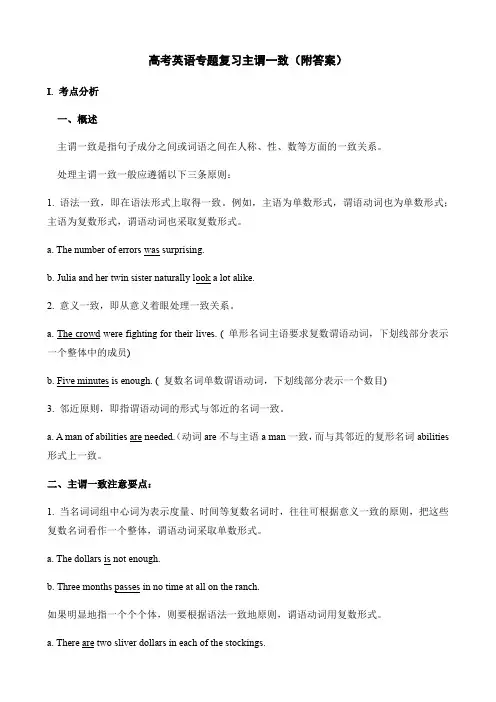
高考英语专题复习主谓一致(附答案)I. 考点分析一、概述主谓一致是指句子成分之间或词语之间在人称、性、数等方面的一致关系。
处理主谓一致一般应遵循以下三条原则:1. 语法一致,即在语法形式上取得一致。
例如,主语为单数形式,谓语动词也为单数形式;主语为复数形式,谓语动词也采取复数形式。
a. The number of errors was surprising.b. Julia and her twin sister naturally look a lot alike.2. 意义一致,即从意义着眼处理一致关系。
a. The crowd were fighting for their lives. ( 单形名词主语要求复数谓语动词,下划线部分表示一个整体中的成员)b. Five minutes is enough. ( 复数名词单数谓语动词,下划线部分表示一个数目)3. 邻近原则,即指谓语动词的形式与邻近的名词一致。
a. A man of abilities are needed.(动词are不与主语a man一致,而与其邻近的复形名词abilities 形式上一致。
二、主谓一致注意要点:1. 当名词词组中心词为表示度量、时间等复数名词时,往往可根据意义一致的原则,把这些复数名词看作一个整体,谓语动词采取单数形式。
a. The dollars is not enough.b. Three months passes in no time at all on the ranch.如果明显地指一个个个体,则要根据语法一致地原则,谓语动词用复数形式。
a. There are two sliver dollars in each of the stockings.2. 如果名词词组中心词是all, most, half, the last, the rest, the remainder等词组时,其主谓关系一般遵循意义一致的原则:如所指为复数意义,谓语动词用复数形式;如所指为单数意义,则谓语动词用单数形式。
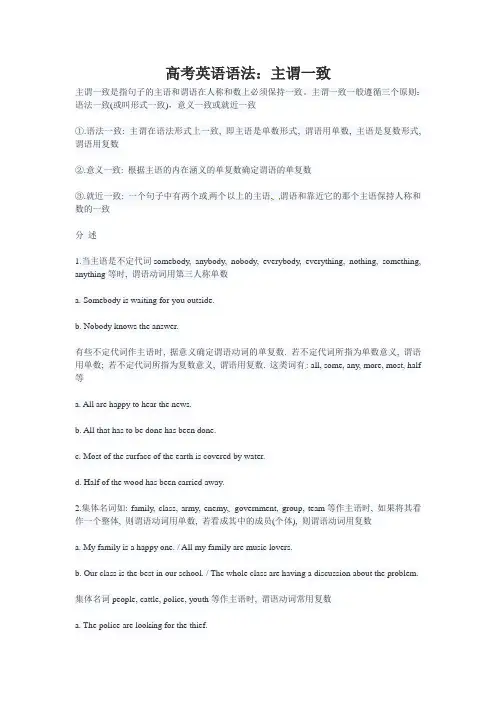
高考英语语法:主谓一致主谓一致是指句子的主语和谓语在人称和数上必须保持一致。
主谓一致一般遵循三个原则:语法一致(或叫形式一致),意义一致或就近一致①.语法一致: 主谓在语法形式上一致, 即主语是单数形式, 谓语用单数, 主语是复数形式, 谓语用复数②.意义一致: 根据主语的内在涵义的单复数确定谓语的单复数③.就近一致: 一个句子中有两个或两个以上的主语,谓语和靠近它的那个主语保持人称和数的一致分述1.当主语是不定代词somebody, anybody, nobody, everybody, everything, nothing, something, anything等时, 谓语动词用第三人称单数a. Somebody is waiting for you outside.b. Nobody knows the answer.有些不定代词作主语时, 据意义确定谓语动词的单复数. 若不定代词所指为单数意义, 谓语用单数; 若不定代词所指为复数意义, 谓语用复数. 这类词有: all, some, any, more, most, half 等a. All are happy to hear the news.b. All that has to be done has been done.c. Most of the surface of the earth is covered by water.d. Half of the wood has been carried away.2.集体名词如: family, class, army, enemy,government, group, team等作主语时, 如果将其看作一个整体, 则谓语动词用单数, 若看成其中的成员(个体), 则谓语动词用复数a. My family is a happy one. / All my family are music lovers.b. Our class is the best in our school. / The whole class are having a discussion about the problem.集体名词people, cattle, police, youth等作主语时, 谓语动词常用复数a. The police are looking for the thief.b. Cattle are not allowed to graze here.3.代词none和neither作主语时, 谓语动词根据说话人的意思用单数或复数. 当说话人着眼于任何一个都不时, 谓语动词用单数; 当说话人着眼于全都不时, 谓语动词用复数a. None of them has a car. ( 他们没有一个人有汽车)b. None of them have a car. ( 他们都没有汽车)c. None of them knows the answer. ( 他们两个谁也不知道答案)d. None of them know the answer. ( 他们两个都不知道答案)4.bothand连接两个主语时, 谓语动词通常用复数. eitheror, neithernor, not onlybut also, notbut 连接两个主语时, 采取就近原则, 即谓语动词和靠近它的那个主语保持一致a. Both Tom and Jerry were late for school that day.b. Either you or he has dropped waste paper in the street.c. Neither he nor I have forgotten for pay for the drinks.5.在There be和Here be结构中, 句子的主语在be之后, 如果主语不止一个, 那么谓语动词be与邻近的主语一致a. There is a desk, a table, three chairs in the room.b. There are three chairs, a desk and a table in the room.c. Here are two letters and a magazine for you.6.如果主语后面跟有with, together with, along with, as well as, but, except, besi des, including, like, rather than, no less than, in addition to(除外)等引导的短语时, 谓语动词的形式只与主语有关, 而与其后的短语无关a. The teacher with three student s was in the classroom then.b. This book, as well as the other two books, is borrowed from our school library.c. None but Jim and Mike knows my secret.d. Seven people, including a policeman, were killed.7.表示时间, 长度, 距离, 金额, 价值, 重量, 容量等的复数名词作主语时, 通常作整体看待, 即表示总量或总和, 谓语动词用单数. 若把它们看作一个个的个体, 即强调其具体数量时, 谓语动词用复数形式a. Twenty years is a long time to us.b. Two hundred miles is not a long distance.c. Ten thousand US dollars is a lot of money.d. There are ten minutes left.8.在四则运算中, 谓语动词用单复数均可, 但单数形式更为多用a. Two and ten is / are twelve.b. Three times five is / are fifteen.9.动名词或动词不定式作主语时, 谓语动词用单数a. Smoking / To smoke is a bad habit.b. Carving animal bones is not an easy job.10.主语从句作主语时, 谓语动词通常用单数. 但若主语从句所指的具体内容为复数意义时, 谓语动词用复数a. What we need is more time.b. What we need are more doctors.11.以-s结尾的专有名词作主语时, 谓语动词通常用单数, 这类专有名词如: General Motors(通用汽车公司), the United Nations(联合国), the United States, the New York Times(纽约时报)等.a. The New York Times is published daily.b. The Arabian Nights is a popular reading among the young people.表示群岛, 山脉, 瀑布的专有名词作主语时, 谓语动词通常用复数, 如:the Andes(安第斯山脉), the Alps(阿尔卑斯山脉), the West Indies(西印度群岛), the Niagara Falls(尼加拉大瀑布)12.有些形式为复数, 而意义为单数的名词作主语时, 谓语动词用单数. 这类名词如: news, works(工厂), politics(政治), physics(物理), mathematics(数学 )等13.以-s或-es结尾, 由对称的两部分构成的物体作主语时, 谓语动词用复数. 这类物体如: trousers, glasses, jeans(牛仔裤), scissors(剪刀), shades(太阳镜)等. 如果这类名词前用了pair, 则谓语动词的数取决于pair的数a. Here is a pair of glasses for you.b. There are three pairs of jeans in the bag.14. 分数或百分数+ of + 名词作主语时, 谓语动词视名词的可数与否采用单数或复数a. Over three quarters of the city was destroyed in the war.b. 35 percent of the do ctors are women.c. Thirty percent of the workers are out of work now.d. One third of the water has been wasted.15.用and连接两个或两个以上的单数名词作主语时, 谓语动词用复数. 如果and连接的两个名词指的是同一人、事、物或概念( 如: a knife and f ork一副刀叉, the bread and butter奶油面包, my house and home我的家)时, 则谓语动词用单数a. Many books and a pen are on the desk.b. The pianist and composer (钢琴家兼作曲家) has come to this small town.16. the + adj.表示一类人或事物作主语时, 谓语动词用复数. the +adj.若表示抽象概念或品质, 则谓语用单数a. The old in the city are taken good care of.b. The beautiful gives pleasure to all of us.美给我们以快乐17.more than one和many a + 单数名词作主语时, 谓语用单数a. Many a student has won the prize.很多学生获了奖b. More than one person has made the same mistake.不止一人犯了同样的错误。
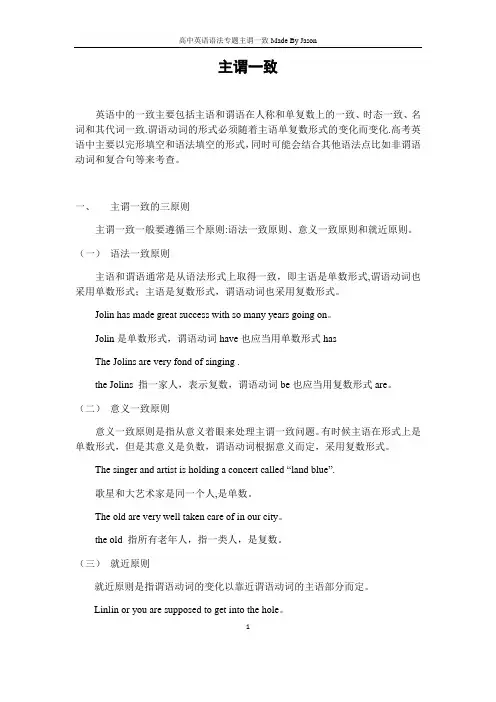
主谓一致英语中的一致主要包括主语和谓语在人称和单复数上的一致、时态一致、名词和其代词一致.谓语动词的形式必须随着主语单复数形式的变化而变化.高考英语中主要以完形填空和语法填空的形式,同时可能会结合其他语法点比如非谓语动词和复合句等来考查。
一、主谓一致的三原则主谓一致一般要遵循三个原则:语法一致原则、意义一致原则和就近原则。
(一)语法一致原则主语和谓语通常是从语法形式上取得一致,即主语是单数形式,谓语动词也采用单数形式;主语是复数形式,谓语动词也采用复数形式。
Jolin has made great success with so many years going on。
Jolin是单数形式,谓语动词have也应当用单数形式hasThe Jolins are very fond of singing .the Jolins 指一家人,表示复数,谓语动词be也应当用复数形式are。
(二)意义一致原则意义一致原则是指从意义着眼来处理主谓一致问题。
有时候主语在形式上是单数形式,但是其意义是负数,谓语动词根据意义而定,采用复数形式。
The singer and artist is holding a concert called “land blue”.歌星和大艺术家是同一个人,是单数。
The old are very well taken care of in our city。
the old 指所有老年人,指一类人,是复数。
(三)就近原则就近原则是指谓语动词的变化以靠近谓语动词的主语部分而定。
Linlin or you are supposed to get into the hole。
1You是最靠近谓语动词的主语部分,因此be动词应当用复数形式的are。
二、主谓一致的详细讲解(一)代词作主语1.不定代词either,neither, each, one,the other,another以及复合不定代词someone,somebody等作主语,谓语动词用单数。
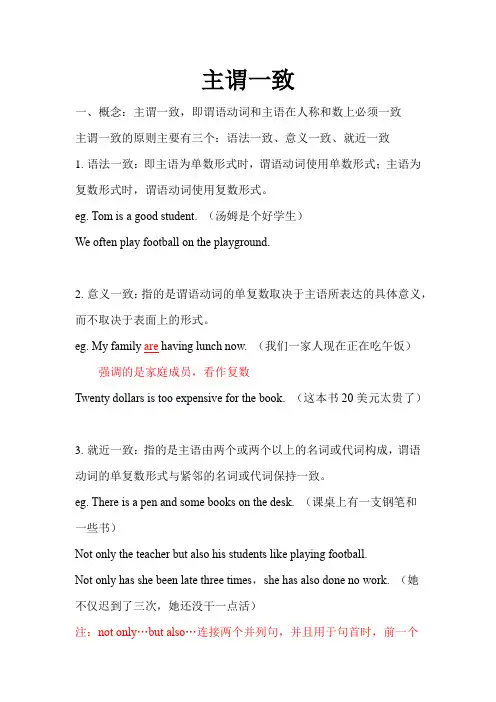
主谓一致一、概念:主谓一致,即谓语动词和主语在人称和数上必须一致主谓一致的原则主要有三个:语法一致、意义一致、就近一致1.语法一致:即主语为单数形式时,谓语动词使用单数形式;主语为复数形式时,谓语动词使用复数形式。
eg. Tom is a good student. (汤姆是个好学生)We often play football on the playground.2.意义一致:指的是谓语动词的单复数取决于主语所表达的具体意义,而不取决于表面上的形式。
eg. My family are having lunch now. (我们一家人现在正在吃午饭)强调的是家庭成员,看作复数Twenty dollars is too expensive for the book. (这本书20美元太贵了)3.就近一致:指的是主语由两个或两个以上的名词或代词构成,谓语动词的单复数形式与紧邻的名词或代词保持一致。
eg. There is a pen and some books on the desk. (课桌上有一支钢笔和一些书)Not only the teacher but also his students like playing football.Not only has she been late three times,she has also done no work. (她不仅迟到了三次,她还没干一点活)注:not only…but also…连接两个并列句,并且用于句首时,前一个句子要用部分倒装。
二、谓语动词用单数的情况1.单数名词(代词),不可数名词作主语时,谓语动词要用单数形式。
eg. Some water is in the table. (瓶子里有一些水)A ball is on the floor. (地上有个球)2.many a+单数名词做主语,意为“许多”,但谓语动词要用单数形式。
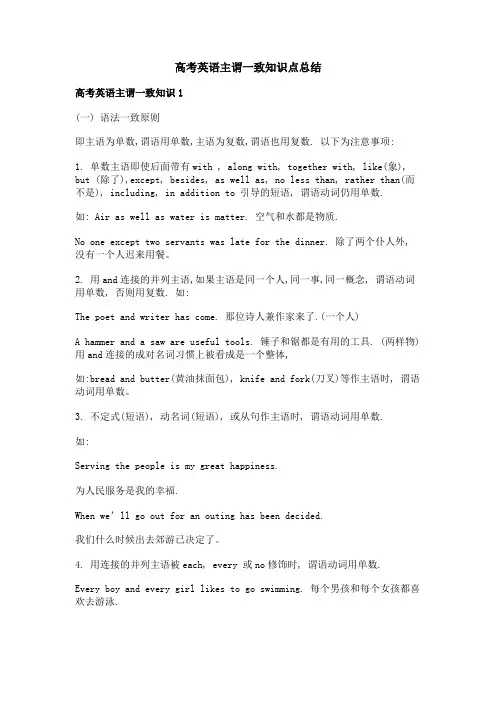
高考英语主谓一致知识点总结高考英语主谓一致知识1(一) 语法一致原则即主语为单数,谓语用单数,主语为复数,谓语也用复数. 以下为注意事项:1. 单数主语即使后面带有with , along with, together with, like(象), but (除了),except, besides, as well as, no less than, rather than(而不是), including, in addition to 引导的短语, 谓语动词仍用单数.如: Air as well as water is matter. 空气和水都是物质.No one except two servants was late for the dinner. 除了两个仆人外, 没有一个人迟来用餐。
2. 用and连接的并列主语,如果主语是同一个人,同一事,同一概念, 谓语动词用单数, 否则用复数. 如:The poet and writer has come. 那位诗人兼作家来了.(一个人)A hammer and a saw are useful tools. 锤子和锯都是有用的工具. (两样物)用and连接的成对名词习惯上被看成是一个整体,如:bread and butter(黄油抹面包), knife and fork(刀叉)等作主语时, 谓语动词用单数。
3. 不定式(短语), 动名词(短语), 或从句作主语时, 谓语动词用单数.如:Serving the people is my great happiness.为人民服务是我的幸福.When we’ll go out for an outing has been decided.我们什么时候出去郊游已决定了。
4. 用连接的并列主语被each, every 或no修饰时, 谓语动词用单数.Every boy and every girl likes to go swimming. 每个男孩和每个女孩都喜欢去游泳.No teacher and no student was absent from the meeting. 没有老师也没有学生开会缺席.Each man and (each) woman is asked to help. 每个男人和每个女人都被请去帮忙。
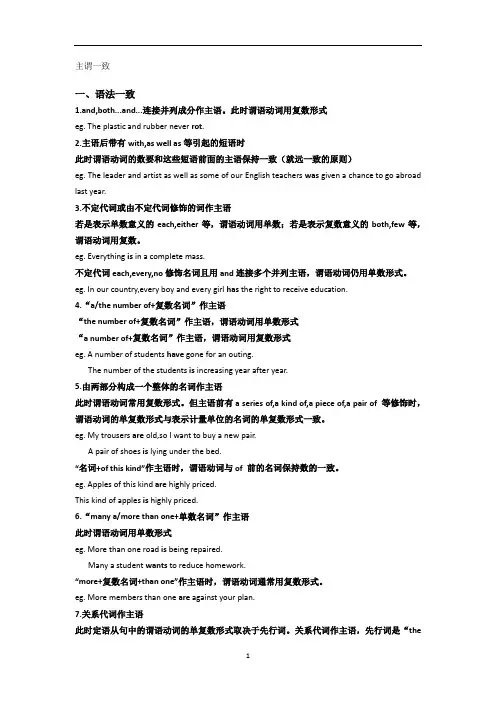
主谓一致一、语法一致1.and,both...and...连接并列成分作主语。
此时谓语动词用复数形式eg. The plastic and rubber never rot.2.主语后带有with,as well as等引起的短语时此时谓语动词的数要和这些短语前面的主语保持一致(就远一致的原则)eg. The leader and artist as well as some of our English teachers was given a chance to go abroad last year.3.不定代词或由不定代词修饰的词作主语若是表示单数意义的each,either等,谓语动词用单数;若是表示复数意义的both,few等,谓语动词用复数。
eg. Everything is in a complete mass.不定代词each,every,no修饰名词且用and连接多个并列主语,谓语动词仍用单数形式。
eg. In our country,every boy and every girl has the right to receive education.4.“a/the number of+复数名词”作主语“the number of+复数名词”作主语,谓语动词用单数形式“a number of+复数名词”作主语,谓语动词用复数形式eg. A number of students have gone for an outing.The number of the students is increasing year after year.5.由两部分构成一个整体的名词作主语此时谓语动词常用复数形式。
但主语前有a series of,a kind of,a piece of,a pair of 等修饰时,谓语动词的单复数形式与表示计量单位的名词的单复数形式一致。
eg. My trousers are old,so I want to buy a new pair.A pair of shoes is lying under the bed.“名词+of this kind”作主语时,谓语动词与of 前的名词保持数的一致。
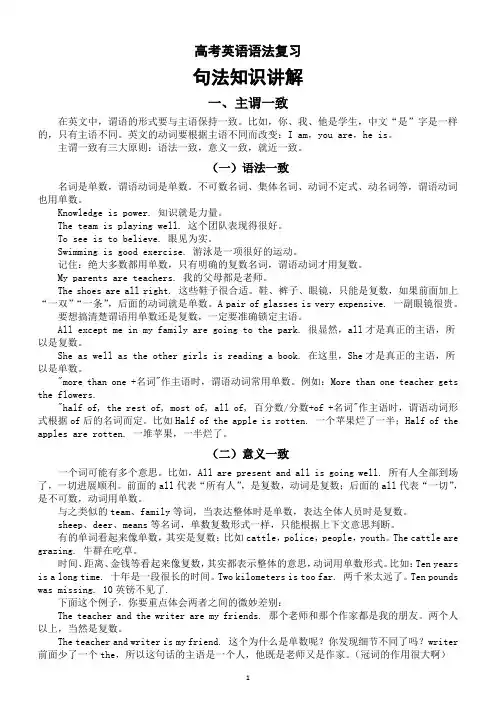
高考英语语法复习句法知识讲解一、主谓一致在英文中,谓语的形式要与主语保持一致。
比如,你、我、他是学生,中文“是”字是一样的,只有主语不同。
英文的动词要根据主语不同而改变:I am,you are,he is。
主谓一致有三大原则:语法一致,意义一致,就近一致。
(一)语法一致名词是单数,谓语动词是单数。
不可数名词、集体名词、动词不定式、动名词等,谓语动词也用单数。
Knowledge is power. 知识就是力量。
The team is playing well. 这个团队表现得很好。
To see is to believe. 眼见为实。
Swimming is good exercise. 游泳是一项很好的运动。
记住:绝大多数都用单数,只有明确的复数名词,谓语动词才用复数。
My parents are teachers. 我的父母都是老师。
The shoes are all right. 这些鞋子很合适。
鞋、裤子、眼镜,只能是复数,如果前面加上“一双”“一条”,后面的动词就是单数。
A pair of glasses is very expensive. 一副眼镜很贵。
要想搞清楚谓语用单数还是复数,一定要准确锁定主语。
All except me in my family are going to the park. 很显然,all才是真正的主语,所以是复数。
She as well as the other girls is reading a book. 在这里,She才是真正的主语,所以是单数。
"more than one +名词"作主语时,谓语动词常用单数。
例如:More than one teacher gets the flowers."half of, the rest of, most of, all of, 百分数/分数+of +名词"作主语时,谓语动词形式根据of后的名词而定。
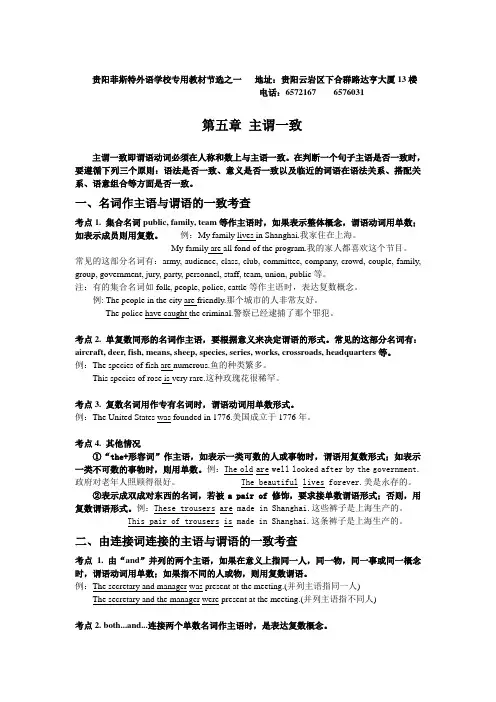
贵阳菲斯特外语学校专用教材节选之一地址:贵阳云岩区下合群路达亨大厦13楼电话:6572167 6576031第五章主谓一致主谓一致即谓语动词必须在人称和数上与主语一致。
在判断一个句子主语是否一致时,要遵循下列三个原则:语法是否一致、意义是否一致以及临近的词语在语法关系、搭配关系、语意组合等方面是否一致。
一、名词作主语与谓语的一致考查考点1. 集合名词public, family, team等作主语时,如果表示整体概念,谓语动词用单数;如表示成员则用复数。
例:My family lives in Shanghai.我家住在上海。
My family are all fond of the program.我的家人都喜欢这个节目。
常见的这部分名词有:army, audience, class, club, committee, company, crowd, couple, family, group, government, jury, party, personnel, staff, team, union, public等。
注:有的集合名词如folk, people, police, cattle等作主语时,表达复数概念。
例: The people in the city are friendly.那个城市的人非常友好。
The police have caught the criminal.警察已经逮捕了那个罪犯。
考点2. 单复数同形的名词作主语,要根据意义来决定谓语的形式。
常见的这部分名词有:aircraft, deer, fish, means, sheep, species, series, works, crossroads, headquarters等。
例:The species of fish are numerous.鱼的种类繁多。
This species of rose is very rare.这种玫瑰花很稀罕。

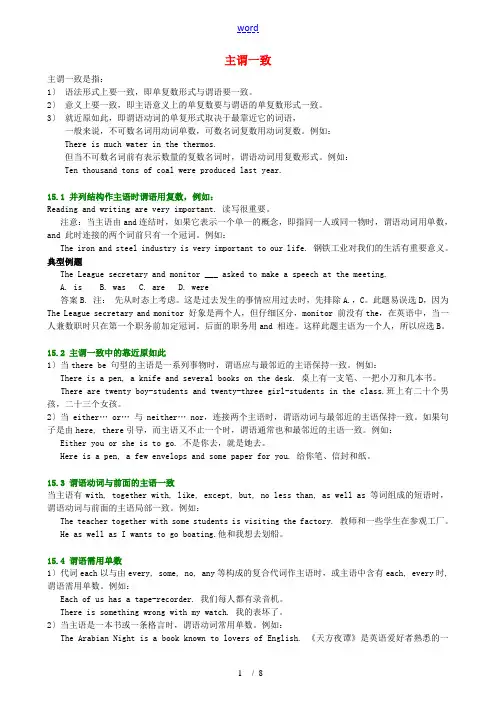
主谓一致主谓一致是指:1〕语法形式上要一致,即单复数形式与谓语要一致。
2〕意义上要一致,即主语意义上的单复数要与谓语的单复数形式一致。
3〕就近原如此,即谓语动词的单复形式取决于最靠近它的词语,一般来说,不可数名词用动词单数,可数名词复数用动词复数。
例如:There is much water in the thermos.但当不可数名词前有表示数量的复数名词时,谓语动词用复数形式。
例如:Ten thousand tons of coal were produced last year.15.1 并列结构作主语时谓语用复数,例如:Reading and writing are very important. 读写很重要。
注意:当主语由and连结时,如果它表示一个单一的概念,即指同一人或同一物时,谓语动词用单数,and 此时连接的两个词前只有一个冠词。
例如:The iron and steel industry is very important to our life. 钢铁工业对我们的生活有重要意义。
典型例题The League secretary and monitor ___ asked to make a speech at the meeting.A. isB. wasC. areD. were答案B. 注:先从时态上考虑。
这是过去发生的事情应用过去时,先排除A.,C。
此题易误选D,因为The League secretary and monitor 好象是两个人,但仔细区分,monitor 前没有the,在英语中,当一人兼数职时只在第一个职务前加定冠词。
后面的职务用and 相连。
这样此题主语为一个人,所以应选B。
15.2 主谓一致中的靠近原如此1〕当there be 句型的主语是一系列事物时,谓语应与最邻近的主语保持一致。
例如: There is a pen, a knife and several books on the desk. 桌上有一支笔、一把小刀和几本书。
主谓一致英语中,主语的“人称”和“数”要限制,决定谓语动词的形式变化,这就叫“主谓一致”关系。
通常依据三项原则:1)语法一致;2)意义一致;3)就近一致。
【语法一致原则】I.主语的“人称”决定谓语动词的形式。
①I love / She loves music. 我/她爱好音乐。
②Are your mother a worker ? (误)你母亲是工人吗?③Is your mother a worker ?(主语your mother 是单数第三人称)II.主语的“数”决定谓语动词的形式。
1.“不可数名词、可数名词单数、单数代词、不定式(短语)、动名词(短语)”或“从句”等作主语,用单数谓语形式。
①The work is important. 这项工作重要。
②To serve the country is our duty. 为祖国服务是我们的义务。
③ How and why he left was a sad story. 他离开的经过和原因是一段伤心的经历。
2. 复数的名词、代词一般接复数谓语形式。
①The children are taken good care of. ②They have gone to Shanghai.II. 以“and ”或“both… and”连接的并列主语:1.通常作复数用。
①Plastics and rubber never rot. ②What he says and what he does do not agree. ③Both Tom and I are fond of medicine.2. 如果并列主语指的是“同一个”人(事、物、抽象概念),作单数用。
①The worker and writer has come. 这位工人作家来了。
②Truth and honesty is the best policy. 真诚是最好的策略。
③A cart and horse was seen in the distance. 远处能看见有一套马车。
语法复习二、主谓一致在英语句子里,谓语受主语支配,其动词必须和主语在人称和数上保持一致,这就叫主谓一致。
寻其规律,大致可归纳为三个原则,即语法一致、逻辑意义一致和就近一致原则。
(一)语法一致原则:语法上一致就是谓语动词和主语在单、复数形式上保持一致。
1、以单数名词或代词、动词不定式短语、动名词短语或从句作主语时,谓语动词一般用单数形式;主语为复数时,谓语动词用复数形式。
如:His father is working on the farm. / To study English well is not easy. / What he said is very important for us all. / The children were in the classroom two hours ago. / Reading in the sun is bad for your eyes.注意:由what引导的主语从句,后面的谓语动词多数情况用单数形式,但若表语是复数或what从句是一个带有复数意义的并列结构时,主句的谓语动词用复数形式。
如:What I bought were three English books. / What I say and do is (are) helpful to you.2、由连接词and或both … and连接起来的合成主语后面,要用复数形式的谓语动词。
如:Lucy and Lily are twins. / She and I are classmates. / The boy and the girl were surprised when they heard the news. / Both she and he are Y oung Pioneers.注意:①若and所连接的两个词是指同一个人或物时,它后面的谓语动词就应用单数形式。
如:The writer and artist has come.; / ②由and连接的并列单数主语前如果分别有no, each, every more than a (an) , many a (an)修饰时,其谓语动词要用单数形式。
主谓一致有许多原则,概括起来不外乎三种一致原则,即:语法一致;意义一致(语言内容上一致);毗邻一致(谓语动词的单复数形式和紧位于其前的主语一致)。
一,语法一致原则语法一致原则是指句子的主语和谓语在语法形式上一致,即通常情况下,谓语动词的单复数形式依主语的单复数形式而定,主语为单数形式时谓语动词用单数形式,主语为复数形式时谓语动词也用复数形式。
掌握主谓一致考点中的语法一致原则,要注意特殊问题1 主语是不可数名词或抽象概念,谓语常用单数。
例如Seeing is beliving. Water is essential to our life.2. 如果主语部分是“分数或百分数+of+名词/代词”,谓语动词的单复数形式取决于of后的名词或代词的单复数形式。
例如:Two’thirds of the earth’s surface is covered by water. 地球表面的2/3是水域。
// 67 percent of the students are girls in our college(学院). 表示“种类、计量单位”的名词kind, sort, type, form, pair, cup, glass, piece, box, chain, series(单数、复数形式同形)、species(单数、复数形式同形)、ton、meter等与of连用构成主语时,由of之前表示“种类、计量单位”的名词决定谓语动词的形式。
例如:This kind of these apples is sweet. // These kinds of apples are very sweet.3. what, which, who, whose等疑问代词作主语时,根据其所指代的含义来确定谓语动词的形式(若其所指代的含义单数不明确,谓语动词通常用单数形式)。
例如:Which is your room?哪是你的房间?// Which are your rooms?哪几间是你们的房间?// Who is your brother?你兄弟是谁?// Who are League Members?哪些是团员?4主语前、后加修饰语时的主谓一致问题。
上海高考英语语法考点:主谓一致一,概念及基本规则:英语语法的主谓一致原则是指谓语动词的单复数形式与主语保持一致。
1,就近原则:not onl y…but also; not…but; neither…no r; either…or; there be;whether…or; or句型中,谓语动词与相邻的主语保持一致。
例:whetherhe or I am mad. 不是他就是我疯了。
2,就前原则:as well as; together with; rather than; along with; with; without;but; except; like; besides; including,in addition to等连接主语时,谓语动词与前面的主语保持一致。
二、谓语动词通常用单数的情形:1.当主语是一个从句,不定式或动名词时,谓语一般用单数。
但由and 连接两个不定式或动名词时,动词则用复数。
两个主语视为一体时,动词用单数。
主语从句所指物是单数或复数时,谓语用相应单复数。
whether he succeeds or fails doesn't concern me .To play basketball and to go swimming are of great use.Time and tide wait for no man.When and where to build the center hasn’t been decided.What I want is an interesting books while what he expects are two cups of coffee.2.不定代词each, every, no所修饰的名词,即使以and连接成多主语,谓语动词仍用单数。
如:every doctor and every nurse goes there.each, neither, either, everyone, anything, nobody等作主语时,谓语动词用单数。
高考英语语法——主谓一致在英语表达中,句子中的谓语动词在人称和数上要和主语保持一致,我们称之为“主谓一致”。
要做到主谓一致,除了要考虑句中主语的人称和数的变化外,还要考虑到谓语动词的时态和语态的变化。
在这一章中,以主语的变化为主导,引出谓语的可归纳性变化。
主要从并列结构作主语时与谓语的一致和单一主语情况下对谓语的要求,以及其他一些特殊情况下的主谓一致三部分讲解。
典型例句:1.Either he or I am wrong.不是他错了,就是我错了。
2.The singer and dancer comes from Shanghai.那位歌舞演员来自上海。
3.A number of students like playing football.许多学生喜欢踢足球。
一、并列结构作主语时的主谓一致1.由and连接主语时由and连接的两个或多个单数可数名词、不可数名词或者代词作主语时,要根据并列主语所表达的意义或概念来确定谓语动词的单复数形式,可以分为下列几种情况。
A.并列主语表示不同的人、物或概念时,谓语动词用复数形式。
Li Ming and Zhang Hua are good students.李明和张华是好学生。
Like many others,the little tramp and the naughty boy have rushed there is search of gold.像许多其他人一样,这个小流浪汉和这个顽皮的小男孩儿也赶到那儿去寻找金子。
Both rice and wheat are grown in this area.这个地区种植大米和小麦。
(切记:both...and...结构作主语时,谓语动词用复数形式。
)B.并列主语表示同一个人、物或概念时,谓语动词用单数形式。
The professor and writer is speaking at the meeting.那位教授兼作家正在会上发言。
高考英语主谓一致二轮考点讲义1.果and所连接的两个名词指同一人物、同一事物、同一概念时,谓语动词要用单数形式。
例如:Both bread and butter were sold out in that grocery. 那家食品炸货店出售面包和黄油。
Zhang Hua and Li Ming are good students. (指不同的人) 张华和李明是好学生。
The writer and poet has 由and和both…and…连接两个名词或代词作主语时,一般情况下谓语动词用复数形式。
但是如come. (指同一个人) 那位作家兼诗人来了。
Husband and wife forms a family. 夫妻组成家庭。
注意:当两个主语为不可分的东西时,谓语动词用单数形式。
例如:A watch and chain was found on the desk. 桌子上发现了有表链的表。
Bread and butter is nutritious. 奶油面包有营养。
War and peace is a constant theme in history . 战争与和平是历史上一个永恒的主题。
2. 由every…and every…, each…and each…, many a…and many a …, no ...and no…等构成复合主语时,谓语动词用单数形式。
例如:Each man and each woman is invited.每个男人和女人都邀请了。
No boy and no girl is there now. 现在那里没有一个男孩和女孩。
Many a boy and many a girl has been invited.很多男孩和女孩都被邀请了。
In China every boy and every girl has the right to receive education.在中国每个男孩和女孩都有接受教育的权利。
3. 由or, not only... but also..., not…but…, either...or, neither...nor,whether……or……连接主语时,谓语与靠近的主语一致,即就近一致的原则。
例如:He or his brothers were to blame .应该怪他或他的弟兄们。
Either you or I am mad. 要么是你要么是我疯了。
Neither you nor he is right. 你和它都不对。
Not only the teacher but also his family were friendly to me.不仅老师,而且他的家人都对我很友好。
4. 当主语后跟有with, along with, together with, besides, except, like, including, in additionto, as well as, rather than等词时,谓语动词根据前面的主语变化。
例如:All but one were here just now.除了一个,刚才其他所有的(人)都在这里。
A library with five thousand books is offered to the nation.有着五千本书的一个图书馆提供给了国家。
She as well as the other teachers is going t o Nanjing.她和其他老师都要去南京。
A farmer together with some workers is about to help us.一个农民和几个工人即将来帮助我们。
5. 某些词结尾字母为s, 但并不是复数形式,如: physics, maths , economics (经济学), politics,news…作主语时用单数形式。
means, works(著作)单复同形。
例如:Physics is very important. 物理是很重要的。
Every means has been tried.每一种方法都已经试过了。
Every possible means has been used to prevent air pollution ,but the sky is still not clear .6. 当一些由两部分构成的表示衣物或工具的名称作主语时, 谓语用复数形式, 如:trousers , shorts, shoes, glasses, goods, clothes, chopsticks, scissors. 如果这些词由a pair, piece, kind , type ,box + of 修饰,则用单数形式.例如:My trousers are white and his clothes are black. 我的裤子是白色的,他的衣服是黑色的。
A pair of shoes is lying here. 一双鞋放在那里。
These kinds of glasses are popular. (kinds为复数时,谓语动词用复数) 这几种眼镜很流行。
7.单复数同形的名词,如sheep, deer 等做主语时,应根据主语的单复数意义确定谓语动词的形式。
例如:A deer is over there . 那儿有一只鹿。
Some deer are over there . 那儿有几只鹿。
8.population做主语时,通常看作单数,若population前有分数、百分数修饰时,则句子谓语通常用复数。
例如:The population in China is very large and 80% of the population live in rural areas .中国人口很多,其中80%的人住在农村。
9. 复数名词, 如: people, police, public ,crew ,cattle作主语时, 谓语动词用复数形式。
例如:The police like to help people.警察乐于助人。
People are talking abou t the news .人们都在谈论那则新闻.The cattle are grazing in the fields . 牛在地里吃草。
10. 集体名词, 如: family ,crowd ,class ,team ,audience ,committee ,club, group ,enemy , population, government等, 如把它们当作整体看, 谓语动词用单数; 如把它们当作若干个体来看, 谓语动词用复数。
例如:Our family is very happy. 我们的家庭很幸福。
My family are all football fans. 我的家人都是足球迷。
11.表示某一国人或某一民族、种族的人的名词作主语时,谓语动词用复数。
例如:The Chinese were a highly civilized people long before the Europeans .中国人早于欧洲人很久以前就是一个高度文明的民族。
12. 表示距离, 时间, 长度,价值, 金额, 重量等的词, 用复数形式时, 谓语动词一般用单数。
例如:Two thousand dollars is a large sum. 两千美圆是一大笔钱。
Two hours is enough. 两个小时就足够了。
但是算式中表示数字的主语一般视为单数,谓语动词多用单数形式..例如:Five times six makes (make ) thirty . 5乘6等于30.Five plus /and five is / are ten . 5加5等于10 .Ten minus six leaves four . 10 减6 等于4 .Twenty-five divided by five equals five . 25除以5等于5 .13.“more than one+名词”作主语时,谓语动词用单数; “more than two, three ...+名词”作主语时,谓语动词用复数。
例如:More than one boy has been there . 不止一个孩子去过那里。
More than one student is going to be a lawyer in the future . 将来不止一个学生要当律师。
More than two boys have been there . 不止两个孩子去过那里。
14. the + 形容词,表示一类人,谓语动词用复数;若the + 形容词,表示一类物,谓语动词用单数。
例如:The rich are for the decision but the poor are against it.有钱人支持这个决定,但是穷人反对它。
The green is hers. 这件绿色的东西是她的。
The beautiful lives forever. 美是永存的.The best is yet to come . 最好的事情是会到来的.15. 关系代词who, that, which等在定语从句中作主语时,其谓语动词的数应该与句中先行词的数一致。
例如:I , who am only a common worker , will retire in two years.只是个普通工人的我两年后就要退休了。
但是one of +复数名词+从句,从句的谓语动词应用复数,而the ( only/very ) one of +复数名词+从句,从句的谓语动词应用单数。
例如:This is one of the most interesting questions that have been asked .这是所问到的最有趣的问题之一。
Sarah is the only one of the girls who plays in the band .He’s the only one of the boys who was praised .He’s one of the boys who were praised.16. 以what,who ,which 等作主语时,谓语动词视具体情况而定。
例如:Who is a doctor ?What is on the table ?Who are league members ?What are on the table ? (what表复念,故用复数动词)Which is my seat ?Which are our seats ?17.由what引导的主语从句,谓语动词一般用单数形式,但若从句谓语或从句后的表语是复数形式,则谓语动词用复数. 例如:What you said is quite to the point . 你说到点子上去了.What we need are qualified teachers .我们需要的是合格的教师.WhatIsay and think are no business of his .(=What I say and what I think 为具有复数意义的并列结构) 我所说的和想的不管他的事.What I miss badly are those happy hours I spent together with them .比较:What she says and does do not agree. (“说”和“做”是两件事)What she says and does does not matter much . (“说”和“做”为一件事, 总指其行为)注意:由and 连接两个what 从句作主语时,谓语动词要用复数.例如:What he said and what he did were different . 他言行不一致.18.whoever,whatever 和whichever作主语引导名词性从句,只能作单数,从句的谓语自然也采用单数形式.例如:Whatever is left is taken away . 凡是剩下的都被拿走了.Whichever of us fulfills his task first is asked to lend a helping hand to others . 我们之中无论谁先完成自己的任务,都被要求去帮助别人.19.which of+名词/代词(必须是复数)作主语时,谓语动词的形式要根据which 短语表示的意义而定.例如:Which of you has got a computer ?你们中的哪一位有电脑?Which of the boys is /are Young Pioneers ? 哪一个/ 哪几个男孩是少先队员?但是“which of the two+名词复数”结构作主语时,谓语动词要用单数形式。